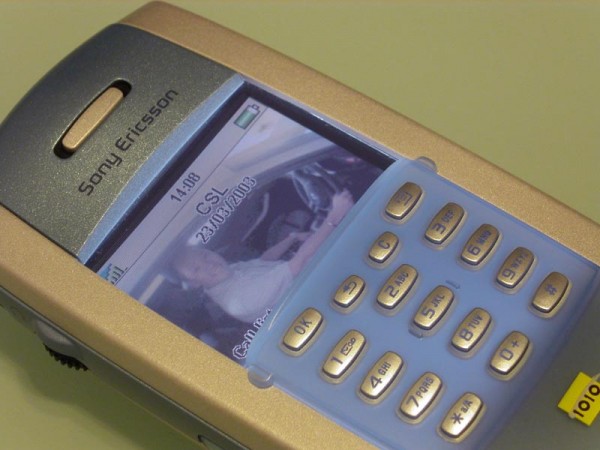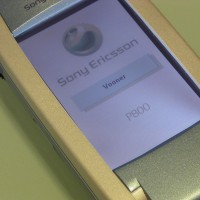Anyone that has followed mobile phone trends has been waiting for the P800 for sometime now. I wrote about it last August in my blog and sadly, Sony Ericsson has delayed the launch again and again. It’s now March, and I’m happy to report that it is finally available.
I was so turned off by the constant waiting that I completely gave up on the P800. With the number of new models that have been coming out, I just couldn’t resist buying other phones in the interim. So finally, when it was available, I hesitated. I just wasn’t sure that the P800 was going to be any good now that we had waited so long for it. But, I had to go see it for myself. So I went by a mobile phone seller and tried out the P800. I have to admit that my initial impressions were much better than I expected. The next thing you know I had ordered one from my provider and it was delivered to me the next morning.
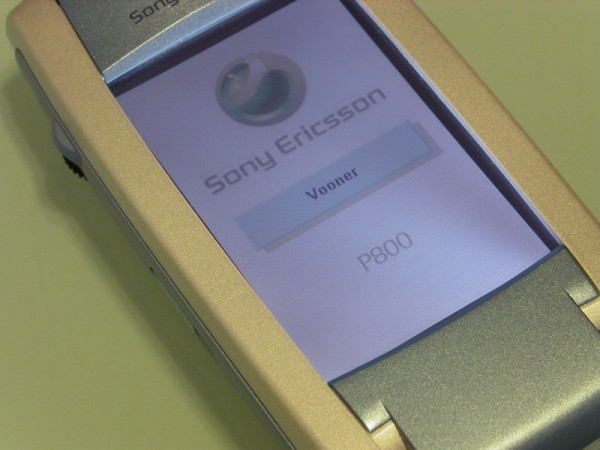
Sony Ericsson P800
Form
The P800 is a pseudo-flip design. What I mean by that is that while the P800 has a flip like function, in fact, that flip “lid” actually can be taken off. You can remove the flip so that the phone only has the screen visible. I did that for a day or two but in the end put the flip back on because it serves two important functions: 1) it’s a lot easier to dial and receive calls with this flip on, and 2) it protects the screen. This latter function is actually pretty important as a mobile phone can get dropped or have things fall on it so you have to protect the screen more so than you would other things. I also didn’t like the virtual dialpad that appears when the flip is removed because it made dialing phone numbers very difficult. Your fingerprints get all over the screen area and it gets pretty ugly and dirty pretty quickly.
Also, the flip actually doesn’t flip like other phones. To answer a call, you just press the OK button, and not actually flip the phone open. To make a call, you dial the number and then press OK again. You don’t flip open the phone like other flip phones. In this regard, the flip isn’t really a flip. You can set it to function more like one, but it wasn’t meant to. In fact, if you flip open the phone while you are making a call, the speakerphone comes on.
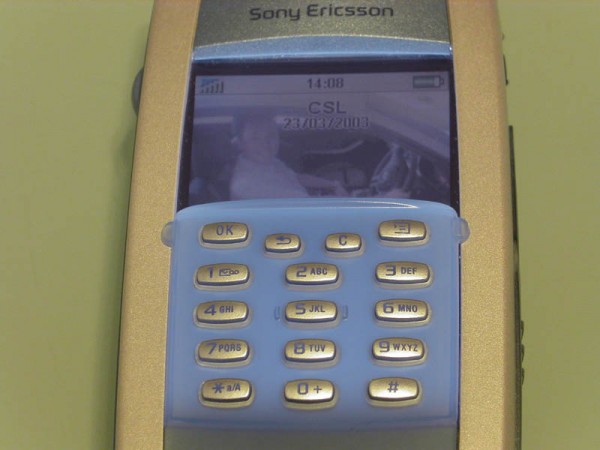
Sony Ericsson P800 front 2
I like the light blue color and the fact that it does not have an antenna. I have become a huge fan of the jog dial now as it makes surfing the menus and options a breeze. I am not though a fan of the silly little pointing device (like a pen) that attaches to the side of the phone (and covers the MS Duo slot). Sony must have known you would lose these things because they include an extra 3 pens. I much prefer to use one of my extra CLIE pens or the pen from my Tablet PC.
The screen is also slightly disappointing. On the one hand, it’s massive. This is by far the largest screen I have ever had on a mobile phone. On the other hand, coming from the GD88, the 4096 color STN screen is no comparison to the 64k TFT screen. Images are not as sharp, contrast/color is not as vibrant — it’s just not the same. Having said that though, anyone that migrates from a non-color or even the small color Nokia screens will be extremely impressed.
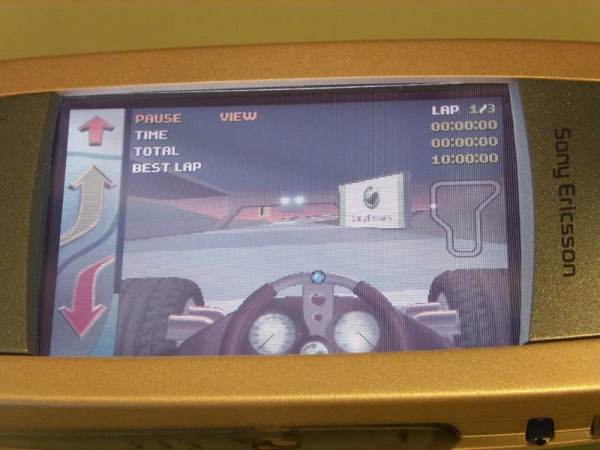
Sony Ericsson P800 game
The one big downside is of course its size. This baby packs a lot of functions as I’ll highlight but it still comes in a very big package. Anyone used to a small Nokia phone is going to get a big surprise as this is not exactly a very “pocket-friendly” mobile phone. It is certainly much bigger than I’m used to but relatively comparable to the Nokia 7650 that I had before. This is probably the biggest hurdle for anyone that is considering a P800.
Function
This is probably the biggest selling point of the P800. I don’t even know where to begin. The P800 didn’t come with a 195 page instruction manual for nothing. This review would take 30 pages if I were to go through every function, so I’ll just touch on the main points and highlight what I think is the most important and interesting. The P800 is so much more than a mobile phone. It has incorporated so much PDA functionality into the phone. Let’s begin first with its function as a mobile phone.
The P800 is, and should be first and foremost, a phone. So I was a little disappointed that in that respect, the quality was mediocre. I don’t know what it was, but even though I had my ear next to the earpiece, the quality of the sound remains unclear. I don’t know how to explain it, versus my Panasonic GD88 or my past Nokia phones, the P800 sounds as if the other party is speaking to you in a tunnel or with something blocking their mics. At first I though it was just my phone or the other person, but I have now come to the conclusion that it is just the P800. In all fairness, the volume on the earpiece is more than ample. The volume level of the earpiece can be cranked up really loud so hearing phone calls isn’t a problem. I don’t know why but the call does not sound crisp or clear. I should say though that the speakerphone works very well and is always an option that I like to have.
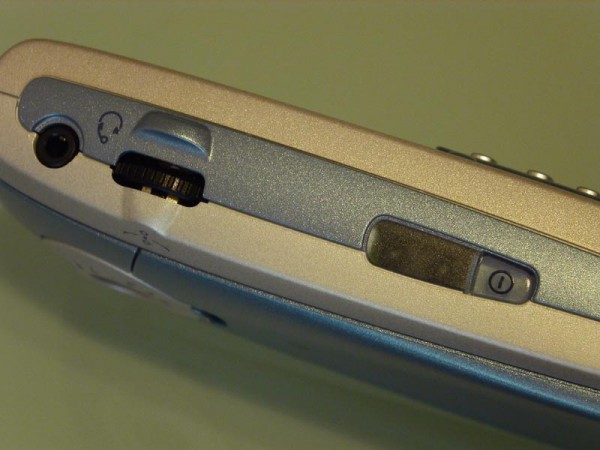
Sony Ericsson P800 buttons
In addition, I feel that the earphone does not do a good job of picking up my voice. Perhaps because of its placement which appears to be on the underside of the phone by the charging contacts. Consequently, when I try to whisper, the P800 does not pick up my voice as well as other mobile phones can.
Making phone calls is intuitively different than other phones and takes some getting used to. For example, you use the same button to start as you do to end a call. I’m so used to different call connect/disconnect buttons that this took some time to get used to. The menu system is also different and takes some time to figure out, with simple functions like finding someone in your directory slightly more difficult. On some occasions, I have found the menu system slow. Normally, the menu system is fairly instantaneous, but like a PDA, the P800 sometimes stalls as you navigate through the different menus. This slight pause is only noticeable when you are used to other mobile phones, but it is noticeable.
A major difference between this and other phones, is that it comes with a cradle docking station which you can (and need) to connect to a computer. The cradle is very much like a PDA cradle where the phone sits on top of it. Unfortunately, Sony Ericsson did a very poor job with the connectors. The P800 does not fit very easily on top of the cradle and you have to spend some time aligning all the contacts. It then takes a bit of effort to connect the P800 as you “wiggle” it into the cradle. All in all, poor ergonomics. Considering the P800 was delayed, you would have though they could get some simple things right. The ease of a Sony CLIE cradle’s would have been well employed here.
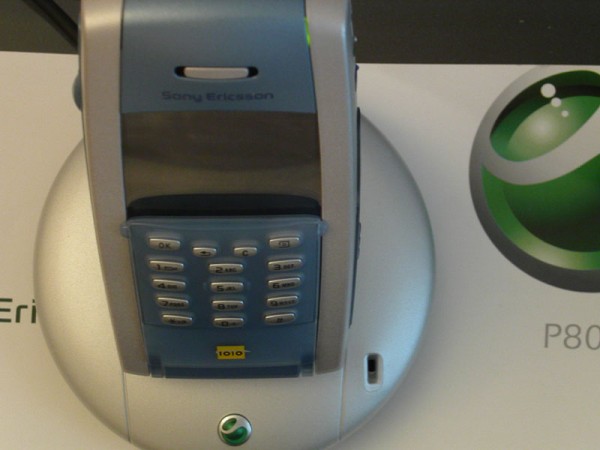
Sony Ericsson P800 docking
Then came the nightmare: installing the software into my PC was a major headache. For the first two hours, I just couldn’t get it to connect. It would not recognize the P800 no matter what I did. I eventually guessed that the problem was my WLAN and after the 20th try of rebooting, true enough, when I turned ON the WLAN, the P800 suddenly worked. Once I overcame this compatibility issue, things went much better. The P800 was synched (although I had to import everything into MS Outlook from my Palm software) and the P800 was now synched with my address book. Finally! I would hate to have to go through that again.
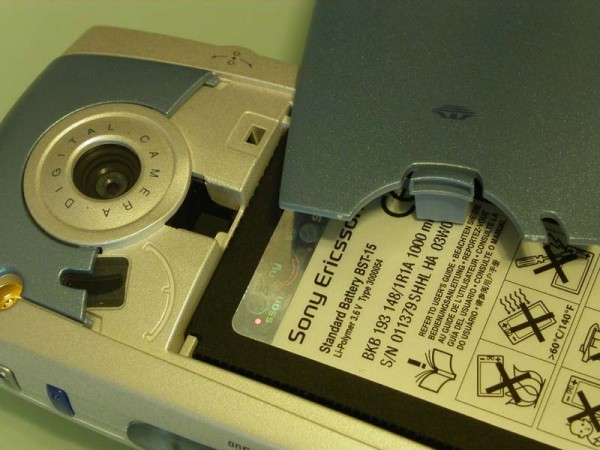
Sony Ericsson P800 battery
Why then do you even need to synch with a PC? (BTW, there is no Mac compatibility so Mac users will be out of luck.) Because you still have to install a bunch of items on the P800. Specifically, items like the games and additional viewers were not pre-installed so before I could show off the P800’s cool gaming capabilities, I had to resolve the PC issue. Total time wasted: over four hours. Finally, I had all the necessary programs and drivers installed and we were ready to see what the P800 could do.
While we are on the subject of the games, I can conclude that in general, they are pretty pathetic. The main two games which showcase the P800 are especially disappointing. The sound and motion of the car game Stunt Run is pretty decent, but using the jog dial to turn left and right is just no fun. It gets pretty boring after awhile. The Men in Black game was even worse. Playing a Doom-like game while using a pen to point at targets to shoot on the screen becomes really lame really fast. Sometimes the simple things are the best: the Chess game and the Solitaire game are fine. Still this isn’t a Gameboy. I saw much better games on the Sharp phone (like Galaga) then what the Sony had to offer. There are a few downloadable games online, but they all seem to cost money and I don’t think I’ll be throwing more money into this phone.
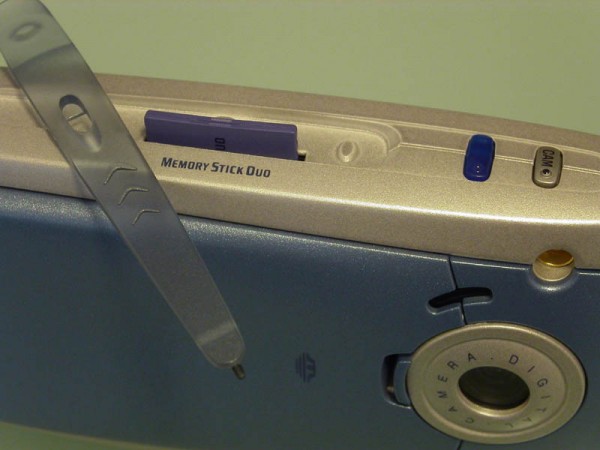
Sony Ericsson P800 slot
The PDA ability to write on the screen is a major plus though. Just when I was getting used to the T9 text input, I don’t need it anymore. You can now enter text right on the screen with the pen or any PDA pen. You can write in the graffiti Palm style or just use normal handwriting. Recognition is actually very good and SMS is now a breeze.
GPRS functionality is a big plus. For the first time, I can now download FULL Internet pages – graphics and all. Of course it still takes quite a bit of time, not to mention that it doesn’t fit very well on the screen, but it is still there. Very cool. MMS and e-mail also works very well.
I only managed to try the Bluetooth with a headset and it works fine, but I have yet to try it with a PC. I’d be curious to see how difficult (or easy) that will be.
The remaining functions are very PDA. You get the standard calendar functions, tasks, voice memo, calculator, clock functions, etc. You have a jotter function which let’s you doodle maps or whatever else you want. One function I really like is the ability of the P800 to view Word, Excel and even Acrobat files. That’s neat. Along with that, the P800 can view MPEG-4 video files. The demonstration file is fairly impressive though I have some reservation as to how useful this function will be. Not until 3G at least. But it’s a step in the right direction.
The two fun functions the P800 excels at are its camera and MP3 capability. The camera on the back of the phone is much better than anticipated, and its larger camera lens gives much better resolution pictures. The P800 can take 640×480 resolution pictures and at fine resolution, the pictures can be as much as 100k each, which is a lot. The camera has a very simple button on the side of the phone for taking pictures and does take very good pictures. It is the best camera on a phone that I have had yet. The music functionality is also impressive with MP3 playback. Though this is not something that I will use often on the P800, it is though a good function to include. The included earphones are fine (they are a different size than usual headphones) and are used for MP3 playback and as a headset for the phone.
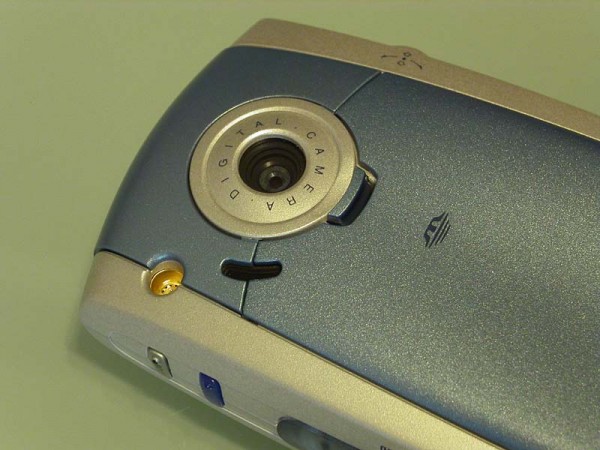
Sony Ericsson P800 camera
Many of these additional functions hinges on the Memory Stick Duo. This new format from Sony is basically a chopped down version of the Memory Stick. Similar in size to the SD format, the MS duo attaches onto the side of the P800 and can be used to store data from the camera, music, video, excel files, etc. You get a 16MB card which isn’t much room but it will do nicely if you just use it for some functions like the camera. With an included MS adapter, you can download additional data to your PC or PDA (like photos taken) thereby saving storage space.
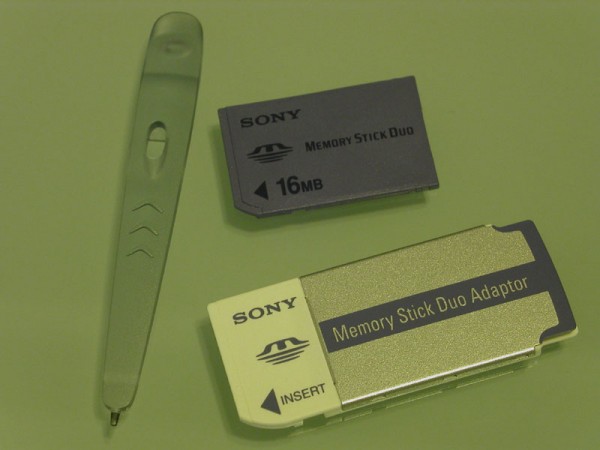
Sony Ericsson P800 ms duo
Factor
I probably haven’t touched on all the functionality and ability of the P800. At the end of the day, it’s a mobile phone with some PDA functions. I think it’s much better than some of the other models out there which are PDAs with some phone functions like the XDA O2 and the Handspring/Palm models. But this is a matter of function. As I have said many times, I have never been a fan of convergent products. The P800 though is a fairly good try. My main disappointment is the size of the device and the screen. Although these are relative issues, having used phones with a better screen and that are much smaller, I just haven’t grown to love the P800 as I thought I would. It is a super cool gadget. But it’s probably got a short term life with theVooner. The P800 may be the coolest phone out there right now, but it’s only something that should be considered if you have MONEY TO BURN. For US$700, the P800 is nearly 50% more than the new Nokia 7250 model which I think may have been a better option. Lastly, after having waited so long, I was tainted slightly by the constant delays though it’s nice to see it finally hit the stores.
